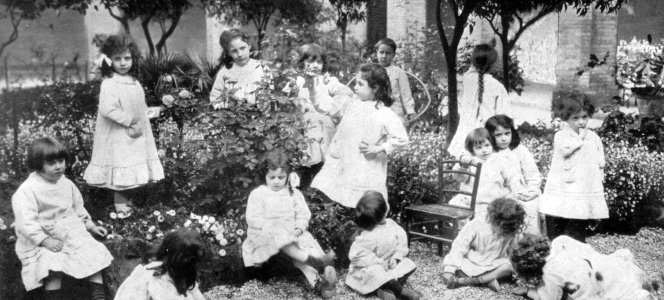A Brief History of Montessori
How has Montessori spread around the world since the opening of the first Montessori class in 1907.
Growth in Europe and Spread to the Rest of the World
In the first Montessori Casa dei Bambini or Children’s House in San Lorenzo, Rome, Italy 1907, Dr Montessori trialled many materials and activities but kept only those to which the children were spontaneously and repeatedly drawn. In this way, the Montessori method developed and grew purely based on what the children showed her about themselves.

By providing an environment with structure and activities that met the interest and needs of the children and by giving them the freedom to move and act within it, it was said that Dr Montessori had revealed the “true nature” of the child. Through her observations and work, she discovered the children’s astonishing, almost effortless ability to learn. Children taught themselves!
A second Casa dei Bambini opened in San Lorenzo on April 7, 1908, and a third in Milan on October 18, 1908. On November 4, 1908, a Casa dei Bambini opened in a modern building for the middle classes in Prati di Castello, Rome. It was soon discovered that all children, whether from economically deprived or privileged backgrounds, were capable of achieving and becoming independent learners when taught using Dr Montessori’s methods.
The news about the ‘miracle children’ spread rapidly, and many important dignitaries and people from many parts of the world came to see the successful and stimulating teaching and learning taking place in the Children’s Houses. One of the first New Zealanders to discover Montessori was Miss Newman, an Auckland Teachers’ College lecturer who visited the Casa dei Bambini in Rome in 1910.
People were inspired by what they saw and conveyed the work when they returned to their homes. In this way, the Montessori movement spread all over the world.
Montessori Publications and Courses
In 1909 the first Montessori training course was given, and Dr Montessori’s first account of the work, The Montessori Method, was published in Italian, appearing in English in 1912. Dr Montessori first visited the United States in 1912, and by 1913 there were almost 100 Montessori schools in the USA. One of the most important 20th-century theorists in child development in Switzerland, Jean Piaget, was influenced by Montessori and served as head of the Swiss Montessori Society.
In the years that followed, Dr Montessori travelled extensively, giving lectures and training courses in England, Spain, Australia, the Netherlands, India, Pakistan and throughout America.
The Montessori method was endorsed and financially backed by people such as Alexander Graham Bell, Thomas Edison, Sigmund and Anna Freud, Mahatma Gandhi and Jean Piaget.
Dr Montessori spent 40 years on four continents, observing children. The Absorbent Mind was published only three years before her death, and this book’s insights about children’s development and the importance of movement in learning are only now receiving recognition from academia as new brain research emerges. The Montessori movement continued to grow worldwide after her death in 1952.
Decline and Growth of Montessori
In the early years Montessori classes catered for children aged 3-6 years. Schools for 6-12 year olds soon followed, and in the late 1930s, Dr Montessori gave guidelines for the education of the adolescent and after World War Two for the infant and toddler. Her son, Mario Montessori, worked until his death in 1982 on maturing the 6-12 cosmic curriculum and the adolescent programme.
The Montessori movement has had periods of flourishing and decline. In many countries, wars or cultural or educational climate changes have halted or changed their course. Sooner or later, it has always reappeared. There was intense interest in the Montessori method in the United States from 1913 until the 1920s. The progressive education movement led by Dr John Dewey significantly affected the decline of Montessori schools, as did the change in focus of American education from child-centred to skills focus during the Depression and World War II. By the late 1950s, only a handful of schools existed in the USA.
In 1969, the Association Montessori Internationale (AMI) supported Nancy McCormick Rambusch to organise a branch in the USA. She later founded the American Montessori Society and established teacher training in Connecticut. This led to a revival of Montessori in the USA, and today there are more than 4000 schools.
Dr Montessori created Association Montessori Internationale (AMI) in 1929 to structure her work and to ensure that it would be perpetuated after her death. AMI was then led by Mario and focused on establishing permanent Montessori centres to train teachers and trainers to continue the centres’ work.
Teachers carried the idea of Montessori back to their own countries, and many national associations and training courses evolved independently. The Montessori revival since 1970 has meant the demand for Montessori has continued unabated.
“Since the death of Mario in 1982, the expansion of Montessori endeavours has grown to a frenzy of inchoate proliferation, a global cacophony, deafening as the sound of a huge orchestra tuning its instruments.” says Dr Montessori’s grand-daughter, Renilde Montessori.





